Circa 1900 German commercial ammunition

LOB example 1.
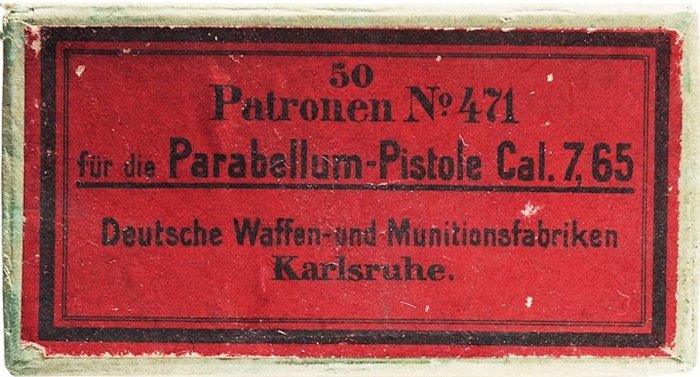
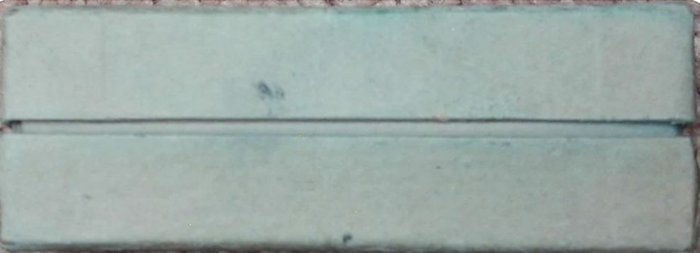
Mouse over image to see inside box.
Click on image to see empty box.
Circa 1900 – 1902 50 – Patronen No. 471 – für die Parabellum-Pistole Cal. 7, 65 –Deutsche Waffen-und Munitionsfabriken – Karlsruhe. with *D.M.*K.* head-stamped ammunition, a.k.a. Deutsche Metallpatronenfabrik – Karlsruhe. with *D.M.*K.* head-stamped ammunition, a.k.a. Deutsche Metallpatronenfabrik – Karlsruhe. [1] Per The Borchardt & Luger Automatic Pistols by Görtz/Sturgess, © 2010 – 2011, figure 20-20 of page 1462 [1] Per The Borchardt & Luger Automatic Pistols by Görtz/Sturgess, © 2010 – 2011, figure 20-20 of page 1462 pictures the subject 50 round ammunition carton in the upper left corner, described in the caption pictures the subject 50 round ammunition carton in the upper left corner, described in the caption to be: the earliest pattern, with deep red label, and double ruled border does not identify the bullet type, and the head-stamp was the first D.M.*K.* style. to be: the earliest pattern, with deep red label, and double ruled border does not identify the bullet type, and the head-stamp was the first D.M.*K.* style.
This very early 1901 German commercial production 50 round boxed ammunition is extremely rare in any condition and exceedingly rare in like-new condition with the original un-faded, deep red label and pale green colored box. and pale green colored box. Pictured are four boxes in the collection in, mostly, superb condition. Pictured are four boxes in the collection in, mostly, superb condition.
LOB example 2.
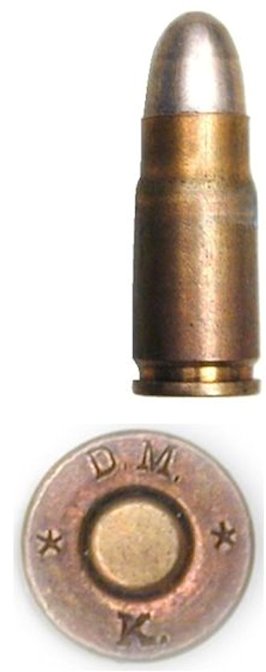 |
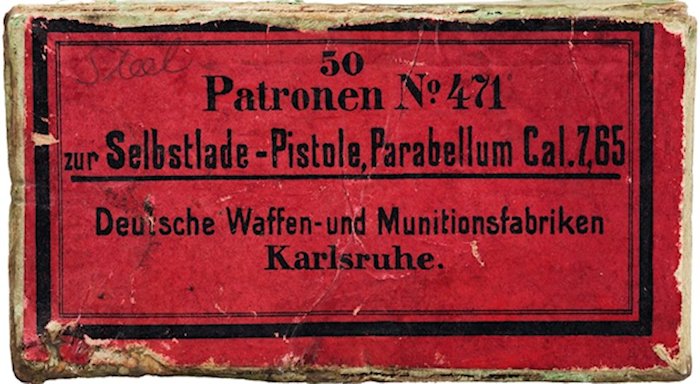
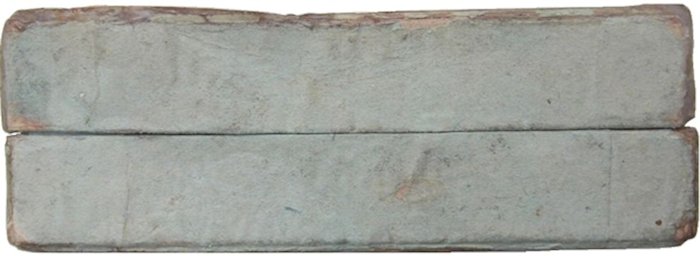 |
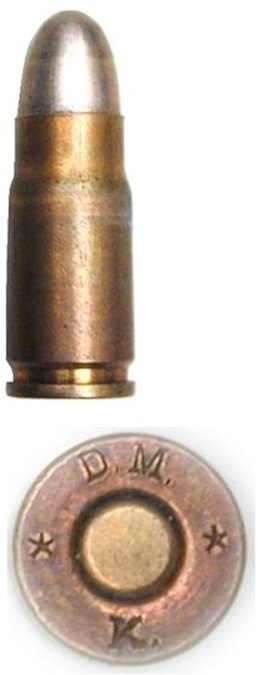 |
| |
Mouse over image to see inside box.
Click on image to see left/right ends of box. |
|
Circa 1900 – 1902 50 – Patronen No. 471 –zur Selbstlade-Pistole, Parabellum Cal 7,65 – Deutsche Waffen-und Munitionsfabriken – Karlsruhe . – The box contains *D.M.*K. head stamped ammunition, a.k.a. Deutsche Metallpatronenfabrik, Karlsruhe. . – The box contains *D.M.*K. head stamped ammunition, a.k.a. Deutsche Metallpatronenfabrik, Karlsruhe.
This is the first published example of another very early box of German commercial ammunition, also with a dark red label, identifying the commercial Pistole Parabellum for the first time as Selbstlade or self-loading, which would appear to be the second earliest label pattern. The box contains 50 rounds of Cal 7, 65 D.M.*K*. head-stamped cartridges, The box contains 50 rounds of Cal 7, 65 D.M.*K*. head-stamped cartridges, identical to the first box, making it contemporaneous to the example 1 labeled pattern box, i.e., superseding the first referenced, apparently short-lived early issue für die Parabellum-Pistole Cal 7, 65 label pattern ammunition. identical to the first box, making it contemporaneous to the example 1 labeled pattern box, i.e., superseding the first referenced, apparently short-lived early issue für die Parabellum-Pistole Cal 7, 65 label pattern ammunition. Note both examples one and two with the early spelling of Cal 7, 65 m/m vs. the later spelling of Kal 7, 65 m/m, instituted per the 1901 German National Orthographic Conference, although not necessarily immediately implemented, and in this case, probably not until the supply of pre-printed Cal 7, 65 m/m marked ammunition labels were used. Görtz/Sturgess in The Borchardt & Luger Automatic Pistols, © 2010 & 2011 Note both examples one and two with the early spelling of Cal 7, 65 m/m vs. the later spelling of Kal 7, 65 m/m, instituted per the 1901 German National Orthographic Conference, although not necessarily immediately implemented, and in this case, probably not until the supply of pre-printed Cal 7, 65 m/m marked ammunition labels were used. Görtz/Sturgess in The Borchardt & Luger Automatic Pistols, © 2010 & 2011 , CHAPTER 20 – PARABELLUM AMMUNITION, page 1462 presents a slightly
different, although equally acceptable description. , CHAPTER 20 – PARABELLUM AMMUNITION, page 1462 presents a slightly
different, although equally acceptable description.
LOB example 3.
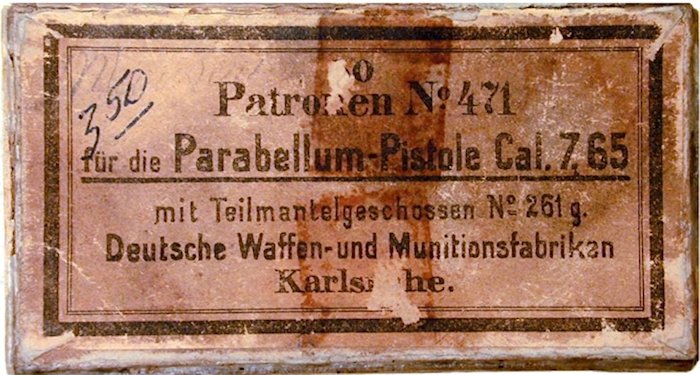
Mouse over image to see inside box.
Circa 1900 – 1902. Another DWM early pattern label titled: 50 – Patronen – für die Parabellum-Pistole Cal. 7, 65 – mit Teilmantelgeschossen No. 261g. – Deutsche Waffen- und Munitionsfabriken – Karlsruhe. –, described by Görtz/Sturgess in the Fig. 20-20 caption as: the earliest label, in the same style, to identify the bullet, was originally also red, but is severely faded, –, described by Görtz/Sturgess in the Fig. 20-20 caption as: the earliest label, in the same style, to identify the bullet, was originally also red, but is severely faded, the carton is filled with cartridges with the DWM K 471 K head-stamp loaded with an uncatalogued open pointed bullet, no. 261g, the carton is filled with cartridges with the DWM K 471 K head-stamp loaded with an uncatalogued open pointed bullet, no. 261g, but does not show the powder load. The Görtz/Sturgess description is mostly accurate except for incorrectly describing the contents as D.W.M. 471 K head stamped, where, in actuality the cartridges are head-stamped with the first D.M.*K* style head-stamp and most importantly loaded with 261g Teilmantelgeschossen or Part jacketed bullets, (steel-jacketed lead core) which is the first known instance of a D.M.*K* style head-stamp with a Teilmantelgeschossen type bullet. The first D.M.*K.* Cal 7, 65 m/m head-stamped cartridges are usually fitted with steel jacketed ball bullets with a lead core. but does not show the powder load. The Görtz/Sturgess description is mostly accurate except for incorrectly describing the contents as D.W.M. 471 K head stamped, where, in actuality the cartridges are head-stamped with the first D.M.*K* style head-stamp and most importantly loaded with 261g Teilmantelgeschossen or Part jacketed bullets, (steel-jacketed lead core) which is the first known instance of a D.M.*K* style head-stamp with a Teilmantelgeschossen type bullet. The first D.M.*K.* Cal 7, 65 m/m head-stamped cartridges are usually fitted with steel jacketed ball bullets with a lead core. The chronological issue status of the subject example three 261g marked carton label in relation to the example one carton is unknown, but certainly precedes example two, mainly due to the similar label information and additionally to the later, per Görtz/Sturgess, “ungrammatical” spelling of Teilmantelgeschossen. The chronological issue status of the subject example three 261g marked carton label in relation to the example one carton is unknown, but certainly precedes example two, mainly due to the similar label information and additionally to the later, per Görtz/Sturgess, “ungrammatical” spelling of Teilmantelgeschossen.
Pictured are two circa 1904/5 Kal 7, 65 m/m marked 50 Patronen (Cartridges) cartons with the single-line rectangular border on the new style printed label that wraps around the left and right side ends, acting as a seal that wraps around the left and right side ends, acting as a seal and further identifying the manufacturer as Deutsche Waffen- und Munitionsfabriken, and now with the box cover label identifying the contents, in this case, 0.32 g Pulver (Powder) – Flachspitzengeschosse (Flat tip bullets) and 0.35 g Pulver (Powder) – Theilmantelgeschosse (Part jacketed bullets). and further identifying the manufacturer as Deutsche Waffen- und Munitionsfabriken, and now with the box cover label identifying the contents, in this case, 0.32 g Pulver (Powder) – Flachspitzengeschosse (Flat tip bullets) and 0.35 g Pulver (Powder) – Theilmantelgeschosse (Part jacketed bullets). Note the mix of old and new spellings, i.e., Kal (later) vs. Cal (early) on the ammunition box labels, combined with the later spelling of Theilmantelgeschosse vs. the earlier spelling of Teilmantelgeschosse. Note the mix of old and new spellings, i.e., Kal (later) vs. Cal (early) on the ammunition box labels, combined with the later spelling of Theilmantelgeschosse vs. the earlier spelling of Teilmantelgeschosse.
The second example ammunition box labeled: zur Selbstlade-Pistole, Parabellum 7, 65 m/m or self-loading represents the final designation of the „Parabellum“ (Luger) used on all following pre WW1 commercial DWM ammunition box labels. The use of the description Selbstlade or Self-loading Pistol, Parabellum ammunition box labels supersedes or pre dates the first DWM German commercial navy manual titled: Die Selbstlade – Pistole, „Parabellum“ – Marine Modell 04 or self-loading represents the final designation of the „Parabellum“ (Luger) used on all following pre WW1 commercial DWM ammunition box labels. The use of the description Selbstlade or Self-loading Pistol, Parabellum ammunition box labels supersedes or pre dates the first DWM German commercial navy manual titled: Die Selbstlade – Pistole, „Parabellum“ – Marine Modell 04 and the extremely rare commercial Luger Carbine four-page sales/instruction “manual” titled: Jagdkarabiner „Parabellum“, interestingly, described as Selbstlader or auto loader. and the extremely rare commercial Luger Carbine four-page sales/instruction “manual” titled: Jagdkarabiner „Parabellum“, interestingly, described as Selbstlader or auto loader. For more information on early DWM commercial ammunition go to the 1900 Parabellum-Pistole ammunition article published on this site in 2005. For more information on early DWM commercial ammunition go to the 1900 Parabellum-Pistole ammunition article published on this site in 2005.

Fig. 20-20: DWM 471 Parabellum Pistol ammunition cartons, left to right, top row:
1) the earliest pattern, with deep red label, and double ruled border does not identify the bullet type, and the head-stamp was the first D.M.*K.* style; 2) LOB collection - the earliest label, in the same style, to identify the bullet was originally also red, but is severely faded, the carton is filled with cartridges with the DWM K 471 K head-stamp loaded with an uncatalogued open pointed bullet, no. 261g, but does not show the powder load;
2) LOB collection - the earliest label, in the same style, to identify the bullet was originally also red, but is severely faded, the carton is filled with cartridges with the DWM K 471 K head-stamp loaded with an uncatalogued open pointed bullet, no. 261g, but does not show the powder load; 3) the green label with Rasetti retailer over label obscuring the DWM address has no cartridge number, but is the earliest pattern to show the powder load second
row:
examples in the standardised format with a single ruled border show the increasing powder charge, from
1) LOB collection - 0.32g, (ca. 1904/5);
3) the green label with Rasetti retailer over label obscuring the DWM address has no cartridge number, but is the earliest pattern to show the powder load second
row:
examples in the standardised format with a single ruled border show the increasing powder charge, from
1) LOB collection - 0.32g, (ca. 1904/5); 2) 0.33g, with side view, showing hand stamped date of loading, 28 AUG 1906 and the measured velocity at 25 m/+15°C hand written in at 335 m/sec; to
3) the normalised 0.35g. Note the archaic spelling of “Theilmantel…” on this 1906 carton compared with the modern spelling “Teilmantel…” on the
similar 0.35 g charge carton and on the earlier box, indicating the erratic application in DWM labels of the modernisation of German spelling in this period.
third row: The range of colours used, which had no obvious meaning, was predominantly blue and green, but included
1) LOB collection - orange, is shown by the Argentine retailer (Carlos Rasetti) marked carton, which is
unfortunately heavily defaced by the distributor over-labels.
2) 0.33g, with side view, showing hand stamped date of loading, 28 AUG 1906 and the measured velocity at 25 m/+15°C hand written in at 335 m/sec; to
3) the normalised 0.35g. Note the archaic spelling of “Theilmantel…” on this 1906 carton compared with the modern spelling “Teilmantel…” on the
similar 0.35 g charge carton and on the earlier box, indicating the erratic application in DWM labels of the modernisation of German spelling in this period.
third row: The range of colours used, which had no obvious meaning, was predominantly blue and green, but included
1) LOB collection - orange, is shown by the Argentine retailer (Carlos Rasetti) marked carton, which is
unfortunately heavily defaced by the distributor over-labels. The label, 2) 3rd row/centre, LOB collection - is export marked “Made in Germany” and dated 1912, with the label print run, 20,000 and printer, C.F., also indicated. Also shown is the progressive variation of the typography, which does seem to reflect age.
The label, 2) 3rd row/centre, LOB collection - is export marked “Made in Germany” and dated 1912, with the label print run, 20,000 and printer, C.F., also indicated. Also shown is the progressive variation of the typography, which does seem to reflect age. The cartons in the bottom rows are post WWI: from 3rd row/right, 1920s, the typography being distinctive; bottom left,
1) LOB collection - a Stoeger US import from the early 1930s, just after Nicorro was introduced, as
the rostfreie Zündung over stamp indicates;
The cartons in the bottom rows are post WWI: from 3rd row/right, 1920s, the typography being distinctive; bottom left,
1) LOB collection - a Stoeger US import from the early 1930s, just after Nicorro was introduced, as
the rostfreie Zündung over stamp indicates; 2) & 3) centre & right, LOB collection - from the late 1930s
2) & 3) centre & right, LOB collection - from the late 1930s , with “Nicorro” priming indicated on the end wrapper. , with “Nicorro” priming indicated on the end wrapper. Note the top row, center box, that the caption incorrectly identifies the carton contents as DWM 471 head-stamped cases,
which should be the first D.M.*K*. type head-stamped cases.
Note the top row, center box, that the caption incorrectly identifies the carton contents as DWM 471 head-stamped cases,
which should be the first D.M.*K*. type head-stamped cases.
Close window
|
|







 with
with 


